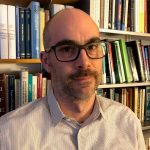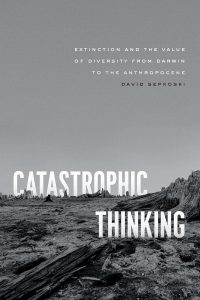7 Questions with David Sepkoski, author of “Catastrophic Thinking”
We live in an age in which we are repeatedly reminded—by scientists, by the media, by popular culture—of the looming threat of mass extinction. Such apocalyptic talk feels familiar to us, but the current fascination with extinction is a relatively recent phenomenon. As David Sepkoski reveals, the way we value biodiversity depends crucially on our sense that it is precarious—that it is something actively threatened, and that its loss could have profound consequences. In his new book, Sepkoski uncovers how and why we learned to value diversity as a precious resource at the same time as we learned to think catastrophically about extinction. We asked him a few questions about it.
In the book, you explain how an “extinction imaginary” helps inform the way we see and value the world around us. Can you give us a quick introduction to that term?
A central claim of this book is that scientific ideas and cultural values can’t be cleanly separated: science doesn’t “cause” us to believe certain things about society or politics, nor do political or social values “explain” particular scientific theories. Rather, the science and culture of a particular place and time are tightly interwoven and reinforce each other by setting the conditions of possibility for thinking and believing certain things rather than others. In the 1980s and 1990s it was popular to apply Michel Foucault’s concept of “discourse” to describe this kind of multicausal interrelationship—and indeed, I sometimes refer to an “extinction discourse” that applied at different times—but I felt that this term misses the important element of imagination that is central to the way societies have conceived and worried about the consequences of extinction. Jedidiah Purdy, in his wonderful book After Nature: A Politics for the Anthropocene (Harvard, 2015), stresses the role of imagination in not just making sense of the world around us, but also in creating “a new way of seeing the world can be a way of valuing it—a map of things worth saving, or of a future worth creating.” This sense of capturing the role of imagination as both a present and a future-oriented activity seemed central to the story I was telling. I also adapted the term “extinction imaginary” from the historian Sara Maza, who used the term “social imaginary” to describe “the cultural elements from which we construct our understanding of the social world” in her book The Myth of the French Bourgeoisie (Harvard, 2003). Ultimately, the “extinction imaginary” is a way of understanding not just how current theories of extinction relate to other social and political values, but also how we imagine the kind of futures we expect or want for the people who come after us.
What drew you to the topic of mass extinction studies, and what do you like about it?
You could say that, in a sense, I was born to write this book: my father, the late paleontologist Jack Sepkoski, was one of the pioneers in studying the patterns and dynamics of mass extinction in the earth’s past. He came up (along with his colleague, Dave Raup) with the concept of the “big five” mass extinctions in the history of life, which he and Raup “discovered” by analyzing fossil data during the early 1980s. I grew up literally talking about mass extinction at the dinner table, and as a kid I first met many of the scientists who appear in later chapters of this book. I even got to meet Carl Sagan, whom my dad knew from meetings about the SETI program and extinction modeling. My last book, Rereading the Fossil Record (Chicago, 2012) is a very in-depth history of the science my dad participated in, and has a chapter about the rise of the “new catastrophism” in paleontology. But I’d always wanted to explore the cultural side of this history as well, especially since I couldn’t help feeling that it can’t be a coincidence that it was exactly when the world was fixated on nuclear annihilation that scientists began to take seriously—for the first time in two hundred years—the possibility that life had experienced major catastrophes in the past. In fact, in grad school back in the late 1990s I very nearly changed my dissertation topic from a study of seventeenth-century mathematics to a scientific/cultural history of “catastrophism.” That idea had kind of been gestating for nearly twenty years, but the rise of the science and politics around the “Anthropocene” gave the story the additional urgency that led me to finally write this book.
You mention that the human species may be poised to go the way of the dinosaurs, victims of the most recent mass extinction some 65 million years ago. Is there anything we can do to, um . . . avoid that?
Ha! In the long term, unfortunately no. The late Dave Raup calculated that average species durations (“survivorship” is the term of art) in the fossil record are about one million years, although some lucky lineages do last much longer. We’re already about two hundred thousand years into ours, and at some point we’re going to go the way of all species. The crucial question, though, is when and how this happens: we have a choice right now about whether to devote ourselves to solving massive global problems like anthropogenic climate change that will play a big part in determining this. Not all species become extinct during catastrophic upheavals, and in fact some species disappear simply because they evolve into a new lineage (paleontologists call this “pseudoextinction”). It would be nice to imagine that’s the fate of our species, isn’t it—maybe someday millions of years from now our evolutionary descendants will populate other planets and solar systems in a modified form. But given the current state of things, I’m not inclined to be particularly optimistic. Let’s put it this way: if we survive the current century, I think our odds go up somewhat.
While working on the book, what did you learn that surprised you the most?
I’ve always been a big fan of apocalyptic speculative fiction—everything from lowbrow stuff about zombies and comet impacts to more literary works like Cormac McCarthy’s The Road or Colson Whitehead’s Zone One. I was somewhat surprised to realize, though, that this genre of fiction basically appeared from nowhere at around the turn of the twentieth century—at least as a popular literary form. Of course, cultures have been fascinated with apocalyptic scenarios for thousands of years, but the interest in—or maybe even ability to imagine—specific kinds of apocalyptic scenarios that might plausibly visit us in the future seems to be a modern invention. Suddenly, around 1895, American and European authors began producing stories and novels that imagined all kinds of speculative catastrophes—plagues, wars, social collapse, aliens—that seem to have reflected the heightened sense of anxiety those societies were experiencing about the very real crises they faced. It makes good sense, though, and became part of the narrative of this book.
Did your research turn up anything interesting that didn’t make it into the final manuscript?
Well, while I was doing archival research about biodiversity conservation during the 1970s and 1980s, I happened to turn up a lot of very interesting correspondence that reflected contemporary debates about biological determinism and human nature. This was simply because some of the scientists who are central to this book were also involved in those debates, and obviously that material didn’t fit the book I was writing. But it did inspire me to write my next book . . .
What’s next for you? Any upcoming projects you’re particularly excited about?
. . . Which is about the science and politics of biological determinism from the era of “sociobiology” (in the 1970s and 1980s) to the Human Genome Project. What I really want to do with this book is to explore why people keep coming back to the idea that we can understand something important about ourselves by looking for genetic or evolutionary markers and explanations for human abilities. Like Catastrophic Thinking, this project is inspired as much by concerns about the present as it is about the past. We’ve seen all kinds of new forms of prejudice emerge over the past couple of decades that gesture at science for support—identitarian politics like White nationalism—but my feeling is that we haven’t taken a close enough look at how science itself is complicit, even unintentionally, in this discourse. This is a big project that I’m just getting started on, thanks in part to a Guggenheim Fellowship I have this year.
What’s the best thing you’ve read lately?
For pleasure, I pretty much only read fiction. I’ve been really enjoying Hilary Mantel’s The Mirror and the Light (the conclusion of her trilogy about the sixteenth-century English advisor to Henry VIII, Thomas Cromwell). I’m also really liking Martin Amis’ new autobiographical novel Inside Story, a lot of which deals with aging and with relationships with various father figures—something I find myself thinking about a lot these days too.

David Sepkoski is the Thomas M. Siebel Chair in the History of Science at the University of Illinois at Urbana-Champaign.
Catastrophic Thinking is available now on our website or from other booksellers.
